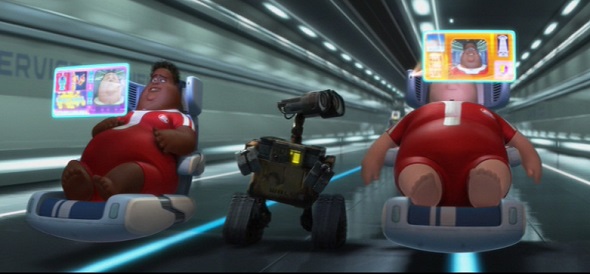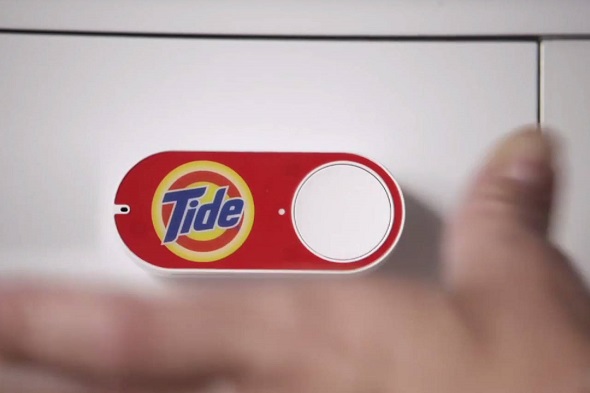
Part of Pixar’s cleverly subversive 2008 hit movie, Wall-E, takes place on a gigantic spacecraft where society resembles life on a cruise ship. People never need to rise from their mobile recliners, so most are overweight and largely fixated on the next thing they can suck out of a cup with a straw. The two kids in this still don’t even look at each other to talk, preferring to engage the ever-present screen floating in front of them.
As a parody of the modern American, it may have its merits, but the vision of a consumer floating in front of a screen while ordering items for instant delivery is something a number of retailers actively work to make real.
In the process, they’re redefining a couple words.
The Meaning of “Convenient”
Amazon, of course, is way out ahead of the curve. They already have same day delivery in select markets. They want drones to fill the skies, delivering orders to doorsteps nationwide. And now, as though to prove that they don’t care how ridiculous they look in the process of realizing their Wall-E dream, they want you to install buttons all over your house so you can order refills of everything from toothpaste to diapers just by hitting one.

The button idea may reveal something about what “convenience” means to a modern consumer. In order to configure the button, which is about the size of a pack of gum and comes emblazoned with the logo of the product it will order, you have to: a) give it access to your home network, b) give it access to your Amazon Prime account, c) tell it how much of the product to order when you press it, and d) set up your Prime account with your phone number so the button can text you to let you know it’s placed an order. You have thirty minutes from that text to cancel – if, for example, your puppy finds the button and, in the process of destroying it, orders fifty mega-packs of toilet paper.
Amazon must assume that the “convenience” of this button will be so compelling that the configuration, and undoubtedly the re-configuration and re-re-configuration, will be worth it. The battery lasts three years, after all, so you can see why Amazon’s bean-counters would relish the idea of having millions of them installed.
The same logic applies to the in-store beacons that have gotten so much press since the holidays. As the ultimate retail-oriented “Internet of Things” (“IoT” to those in-the-know), these beacons theoretically have the power to unite the online and in-store shopping experience.
You know the vision: the customer lingers over an item, and the IoT can tell. So it transmits a message offering additional information, or a discount. Mostly discounts, since their main purpose seems to be turning a mediocre desire into a sale.
One problem: How does the beacon send the message to the customer? Do they have some magical way to get into your phone that other companies haven’t yet developed?
No, they don’t. In order for their beacon to send you a text, you have to install an app.
And what would make you do that, other than to receive discounts? Merchants selling higher-priced items to discerning customers may question the point behind interactive technology ultimately aimed at coupon-cutters.
It’s much easier to see how it might fit WalMart’s business model, because all of its customers are there for the prices, and they know it. More importantly, if discount stores fully integrate beacons first, then the case for following suit may become even less compelling.
The customers you want may be the ones who feel that installing yet another app falls outside their “convenience” threshold. You may prefer to focus your efforts on getting people into your store to begin with.
The Meaning of “Brand”
Which brings us to branding. If it seems like everything must be a brand these days, you’re right.
Individuals are brands. Michelle Phan developed her brand by applying makeup on YouTube. People have watched her do it over a billion times so far. That magic number got Endemol Shine Group, which produces American Idol and The Biggest Loser, among other things, to approach her to launch a new beauty, fashion and lifestyle network.
Because that’s what “brand” means now: something identifiable that has an online presence. From the point of view of a retail establishment owner or manager, it might seem compelling to develop a brand of your own, and the more charismatic might succeed as well as Phan did.
But most will collect together the brands that they sell and will have something interesting to say about them, either in words or in presentation. Your brand arises from your selection of brands, and selecting unknown brands – local artisans, for example – can distinguish you from your competition and endear you to your clientèle.
So can a compelling way to present your merchandise, and deciding how to do this really ought to come down to a cost/benefit analysis for most retailers.
The Meaning of “Real”
If you don’t sell products online, then your website’s cost/benefit analysis is easy: its primary function is to be mobile-friendly so people can call you or find you. It costs you little time, it provides an essential service and thus earns you a major pay-off. Similarly, your Facebook page is mostly someplace your customers can talk about you, which matters but matters less than what they say on Yelp. Setting both up doesn’t take much, and the Yelp account can certainly attract customers.
But it’s possible that those venues, while essential, may not be your real money-makers. If you’re pretty good with a camera, your Instagram site might be the best way to spend your business-related social media effort, because it may have the greatest potential to brand your store, attract new eyes to your merchandise, and develop relationships with prospective customers before they even arrive.
Ooh La Loft in our Petaluma, California hometown gives us one particularly compelling example. Their Instagram account is integrated into their website’s homepage and serves as their company blog – because if “content is king” and you sell clothes, then your content is probably photographs.
And they don’t just post cool shots and hope for the best – as you can see in this capture, they’re right there with a phone number and an offer to ship as soon as someone decides they want something.
They sell new, recycled and locally manufactured clothing, so their Instagram excellence really serves to get people into the store. They give their customers a wonderful dreaming session online, knowing full well that when they’re ready to buy 70% of their viewers will show up in the physical store.
Although this may not bode well for Amazon’s Wall-E vision of the future, in the real world on a warm summer weekend, there’s practically a line to get into this place. For them, the virtual world and the real world have already joined into a seamless whole.
And while you can be certain that practically every mother and daughter there has a smartphone in their hand, you can also be certain that as soon as the shopping spree’s price passes the $100 mark, one in five of those customers – from Millennials to Boomers – will want to pay with a check.
You spent hard-earned time on your cost/benefit analysis for your social media branding, so be sure that your benefit – the sale – falls to your bottom line. Learn how accept checks with the same revenue guarantee you get from a credit card.



